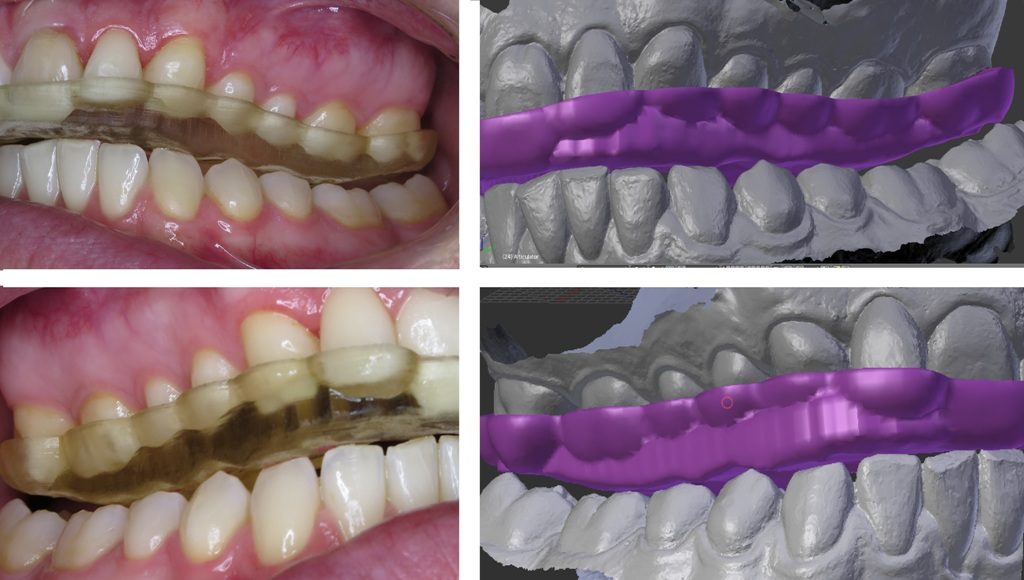What is D3Tool?

What it is now:
D3Tool is the Digital Dental Design Tool for Blender, a project aimed at establishing an open source and easy to use dental CAD that offers freedoms not available in other software. Currently, it is a collection of custom tools written as an add-on to Blender. These tools showcase the potential of what is possible with Blender for digital dentistry. In their current state they do not work together in a cohesive way to make it practical to accomplish those possibilities and that is what this project aims to reconcile. The front page demo reel shows a small set of what has been done in Blender so far to give you an idea.
What it will become:
. The goal of the project is to establish a stable and cohesive framework for the existing tools to work within and to expand upon. What does that mean and why is it important? This is the equivalent to good civil engineering and urban planning that allows a city to efficiently grow and expand in a sustainable way. The end goal is a dental CAD platform that meets the following criteria.
- A low barrier of entry into 3D dentistry for new users.
- Out of the box easy workflows for the most common dental CAD tasks
- Access to data at any point in the CAD process
- Expandable – Easy to to make custom tools, streamline repetitive tasks or do research
- Community Driven – A community supported ecosystem that additional services and education can be built upon.
What it is not:
First and foremost, this is not meant to displace the existing players in the dental CAD space. In fact this project’s very existence is because of how far the pioneers in this space have taken us. However this tool offers an alternative in cost and in some instances an alternative in function. Most likely, D3T will exist as a compliment to the existing CAD packages.



I have already downloaded Blender. Is D3Tool part of the blender software or need to download as a separate software.
D3Tool is an addon package for Blender. Blender from blender.org will not have the functionality you see here. Currently only D3Splint is available for purchase.
Patrick, I just found the D3Tool site. Is there anyway to download just this. I don’t need to splint module. I am really more interested in just basing Dental models.
Rick
rick I haven’t split off the model work into it’s own module yet. That is something I definitely need to do. -P
So if I want to make bite splints do I need both the tool and splint application or just “splint”. What does d3 tool do as a stand alone currently? Thanks you. Great initiative on this project
You only need D3Splint. Right now D3Splint is the only “ready to use” module and it has all of the current model work tools as well. For the time being D3Splint = D3Tool. However we have picked this naming convention in anticipation of a larger future.
Does this work as an add on for blender on Mac OS ?
right now it does not. Certainly it will in the future.
Can you add to the splint to make it an upper and lower splint and add wing to make it into a dorsal appliance for sleep? Thanks
There are no workflows for sleep appliances at this time. You can build opposing appliances that have harmony in their occlusion, and then export to use other softwares to add wings and other non-standad features.
Thank you. If you ever develop the way to make a sleep appliance or directions on how to use tinkercad and meshmixer with this please let me know. That is something I would pay $$ for.
Why it is not recommended for clinical use?
If I recommend it for clinical use, it becomes software as a medical device. Until we can get proper FDA approval I can not market this as a medical device.
Perfect Patrick, thanks for the attention!
Is there a way just to get D3Tool? It is what I am interested in.
Hi Rick, at the moment D3Splint is all the exists in any coherent way. If we reach funding goal I will have D3Tool re-packaged by professional software engineers. If you want to battle it out with my old addon packages for Blender, please see http://www.github.com/patmo141/cut_mesh and http://www.github.com/patmo141/object_alignment
Why is there no video for the trimming and sculpting of a model?
because I have changed the tools dramatically since I made this video. Better to have no information than bad information! Working as fast as we can to stabilize methods and document.
Hello Patrick and Congratulations for your work !
When do you think (approximately) that D3Tool will be ready please ?
Excuse for my English please (I’m French).
Best Regards
Eric
Hi Eric, that is a great question and it needs a little more definition. At the moment, Splints and Model Work are available and working. (Now 4/2018) We have raised $20,000 out of our $50,000 development fundraising goal. I am not going to invest in more new development until we hit that goal, because If we can’t hit that goal by July 2018, then I do not think this project can sustain itself. If we don’t hit the goal, I will continue to support what I have developed personally, but I can not support any more features by myself so will not develop more with the risk of stranding a lot of users with a halfway made project. The Splint and Model tools work, work well, and are worth the price, however I am applying all revenue from their sales to future development, not to profit through the fundraising campaign.
Hi Patrick,
There was a question some months ago about being able to use the software to add wings onto upper and lower “bite splint” type appliances to make them function like a dorsal appliance which is sometimes used for treating TMJ/Bruxism. At this time, if I get your software, does it have the ability to do that for me? If so, I am buying it today and telling everyone I know to get it.
Thanks
Hi Tim, as with all software questions the answer is that it’s definitely possible but my official statement is that it’s not a supported workflow and not going to be as smooth as the other parts of the software. You would need to manually (using standard Blender tools) add in the components to create the dorsal appliance and then merge them with your splint. If you just want to create really good fitting shells that can be customized in Blender using default tools (or taken in to MeshMixer etc), you can do whatever you want with them. Can you provide link or images to the exact appliance style you are referring to.
I pasted 2 separate links to images below. Seems to me it would be doable in theory. I just have no experience as of yet with printing or the software, but am willing to learn if its workable. Thanks
https://www.ryesmilesforlife.com/wp-content/uploads/MicrO2_Device-300×208.jpg
http://assets2.dentalproductshopper.com/product_images/M/Microdental_Laboratories/Web_Image/MicroDental_MicrO2.jpg
https://www.dynaflex.com/wp-content/uploads/2017/04/Dorsal-Splint-DETAIL-%C2%A9-DynaFlex.png
IS there an export fee for 3d printing? I am only interested in the bite splints.
No! No charge for any exports after you purchase the software. You can use it as much as you want with zero ongoing or export fees.
Is there a virtual articulator function? (allowing us to design the occlusal surface flat with point contact and move it around?
Yes Frank, we do it a little different than you may have seen in other CAD’s. We create a “sweep surface” that represents all the possible articulator movements, and then subtract that that, which would be a gorup function or balanced occlusion. we then have a cusp marking tool that allows you to flatten everything except the posterior contacts.
Will the D3Mesh add-on eventually allow us to make splints in a similar manner that D3Splint does?
Hi @petervdds – there aren’t plans in the medium term to make splints in MeshMixer via D3Mesh like D3Splint does with Blender.